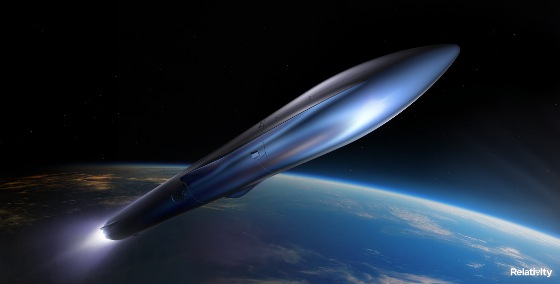 |
| September 14, 2021 | Volume 17 Issue 34 |
Designfax weekly eMagazine
Archives
Partners
Manufacturing Center
Product Spotlight
Modern Applications News
Metalworking Ideas For
Today's Job Shops
Tooling and Production
Strategies for large
metalworking plants
Fully reusable 3D-printed rockets taking shape

Relativity Space is busy getting to work on Terran R, its fully reusable, almost entirely 3D-printed launch vehicle that will be capable of launching 20,000 kg (44,092 lb) to low Earth orbit (LEO). Created in Relativity's Factory of the Future in Long Beach, CA, the company's proprietary 3D-printing process uses software-driven manufacturing, exotic materials, and unique design geometries that are not possible in traditional manufacturing.
Terran R is 20 times larger than Terran 1, the company's first single-use 3D-printed rocket (nominal payload 900 kg/1,984 lb, height 115 ft). Terran 1 already has a mission scheduled for as early as 2022. Both rockets boast 3D-printed bodies and engines -- and a significant reduction in parts compared to traditional rocket manufacturing. There is no fixed tooling, and supply-chain headaches are radically minimized.
The company says its rockets can be made -- in entirety -- in 60 days using its Stargate 3D printers. Parts are inspected during and after printing to ensure they meet the highest standards of uniformity and quality. Terran R will eventually launch from Cape Canaveral at Launch Complex 16, the same launch pad as Terran 1.
A recent TechCrunch article states, "In the mission control center, true to its name, engineers and mission operators will be able to monitor and manage launches that take place in Cape Canaveral, Florida, or Vandenberg Space Force Base in California."
Terran R is designed as a two-stage, 216-ft-tall rocket with a 16-ft diameter and a 5-m payload fairing. It will be outfitted with seven 3D-printed Aeon R rocket engines capable of 302,000 lb of thrust each (2,100,000 lb thrust total), while its upper stage houses one Aeon Vac engine. The rocket uses liquid oxygen and liquid methane for fuel. Relativity has developed multiple high-strength proprietary alloys custom designed for 3D printing to meet its mission-critical performance, although it is keeping tight-lipped on the exact composition of those alloys.
Relativity has secured a 93-acre former Boeing C-17 manufacturing plant in Long Beach, CA, as the site to build a new 1-million-sq-ft headquarters factory. The facility will have capacity for 2,000+ employees, a metallurgical laboratory, DMLS printers (metal laser printing), a mission control center, and dozens of the company's proprietary Stargate 3D printers, which are touted as the largest metal 3D printers in the world.
According to a recent USA Today article, "Like the vertical landing accomplishments pioneered by (SpaceX's) Falcon 9, Terran R will also be reusable. The company is still studying whether it would land on a ship in the Atlantic Ocean, similar to SpaceX's drone ship operations, or pluck the first stage out of the water. The second stage, meanwhile, will also be able to withstand Earth re-entry for recovery from the ocean with its payload fairing still attached -- a feat not even SpaceX has pulled off."
A few updates on #Terran1:
�" Relativity Space (@relativityspace) August 20, 2021
�...We're excited to share that Stage 2 passed cryo pressure proof + hydro mechanical buckling test on our structural test stand. Up next: S1 structural testing!
�...Terran 1's demonstration launch is now set for early 2022 from Cape Canaveral LC-16. pic.twitter.com/nrv1mUCl2t
Terran R aims to provide both government and commercial customers affordable access to space in LEO and beyond. With satellite technology advancements, demand for bandwidth soaring, and satellite constellations representing the largest part of the growing commercial space market, Terran R was developed to accommodate the growing demand for large-constellation launch services and the company's growing pipeline of commercial special projects. Relativity recently signed its first anchor customer launch contract for its Terran R vehicle.
VIDEO: How Relativity is revolutionizing 3D-printed tank design.
The company's rocket design and production has evolved exponentially in its short five-year history. So far, Relativity has secured nine launch contracts for its Terran 1 rocket from both private and government customers, including a recently announced U.S. Department of Defense (DoD) contract facilitated by the Defense Innovation Unit, a Venture Class Launch Services Demonstration 2 contract with NASA, as well as an on-demand satellite launch contract with Iridium.
In the long term, Terran R is slated to offer customers a point-to-point space freighter capable of missions between the Earth, Moon, and Mars.
Learn more at relativityspace.com.
Sources: Relativity Space, USA Today, TechCrunch
Published September 2021
Rate this article
View our terms of use and privacy policy
